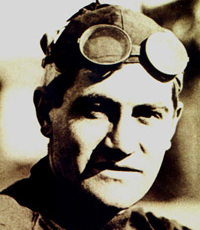
Cyrus Patschke
Relief driver for the winner of the 1911 Indy 500 Race
Nationality: United States
Born: July 6, 1888 Lebanon, Pennsylvania
Died: May 6, 1951 Lebanon, Pennsylvania 63 Years
A Chronicle of Indianapolis “500” Relief Driver Cyrus Patschke
by Marvin E. Scattergood
Cyrus Patschke is one of three relief or substitute drivers that wheeled a winning car in the Indianapolis “500”. The other two are Joe Boyer and Mauri Rose.
Boyer became a co-winner in 1924 after relieving Lora L. Corum on lap 111. In 1941, Rose replaced Floyd Davis near the 180-mile marker. Each reliever then drove to the conclusion of the 200-lap race. Both had made the starting lineup in their own racer but bad luck forced them out. Patschke drove strictly in a relief role.
Boyer and Rose are recognized co-winners and their names along with the drivers each replaced are included in the official Speedway accounts and their likenesses are found on the world renowned BorgWarner Trophy. Yet, Cyrus Patschke is the overlooked one in this elite group.
The inaugural running of the Indianapolis “500” was scheduled and run on Tuesday, May 30, 1911. Howard Marmon had two cars entered and sought two outstanding drivers of the day, Joe Dawson and Ray Harroun. Dawson was promptly hired and assigned the No. 32 racer. A major obstacle needed to be resolved since Harroun had retired from competition following the close of the previous season. Nevertheless, following intense discussions, Mr. Marmon decided to hire a driver exclusively for relief duty and Harroun agreed to come out of retirement
Meanwhile, Patschke had mailed off a letter to Mr. Marmon seeking a driver’s spot on the racing team. History would demonstrate Marmon made a prudent choice and that Harroun did see eye to eye with it. At this moment in time, Patschke was virtually unknown nationwide but had earned measurable respect in the automobile racing community.
On October 15-16, 1909 at Brighton Beach, a community in Coney Island, NY, Cyrus and Ralph Mulford teamed up to win a 24-hour endurance race on a track originally designed for horseracing. One year later, August 19-20, Cyrus with new teammate, Al Poole, won the Brighton Beach endurance race once again. The event covering 1,253 miles averaged over 52mph, bettering the previous record by some 57-miles. Frank B. Stearns who was an early automotive pioneer built the winning Stearns-Six racecar.
It is likely; Cyrus became the Marmon racing team third driver because of his many important qualities. Among these, he was an experienced endurance driver, first-class teammate and confirmed winner.
In the “500”, Patschke demonstrated his talent as he motored the No. 31 yellow Marmon Wasp in contention as he charged forward racing over the 3.2 million bricks on laps 71-102 while Harroun relaxed in the pit area. After Harroun retuned to the Wasp’s seat, the scorekeepers then showed the No. 31 in the lead for the very first time on lap 103. Harroun went on to lead laps 103-137, 143-176 and then taking the number 1 spot for the final time on lap 182 and holding it for the victory.
Patschke also toured the track for at least one lap for Joe Dawson in the No. 32.
Patschke was still a young man in his early twenties, yet he did not drive again at Indianapolis. Even though, he achieved moderate success several more times for Howard Marmon. He had a second behind Harvey Herrick on the 8-mile road course at Santa Monica, CA on October 14, 1911. In the event, Patschke led 11 other starters three separate times but lost the lead late in the race. He also scored a third at Sioux City, Iowa on July 14, 1914, won by friend Eddie Rickenbacker. The 300-mile event ran on a 2-mile track.
After his retirement from racing in 1915, Cyrus was a proprietor of two successful businesses in his hometown of Lebanon, PA on Cumberland Street. A Willys new automobile dealership, and next door he built an auto repair shop which he ran for many years. A nationwide auto parts business now occupies the land on Cumberland.
John N. Willys built the Willys Knight and Overland cars Cyrus sold. Ironically, it was Cyrus’ old friend and racecar owner, Frank B. Stearns that did sell his F.B. Stearns Company to Willys who kept the Stearns-Knight luxury car in production for sometime.
Cyrus’ racing career spanned only 7-years and he competed in only 11 major race events from 1908-1914. His performances yielded eight respectable finishes including: 3-wins, 1 second, 2 thirds, 1 fourth, 1 sixth and only several early retirements.
A recent proud moment for the Patschke desecdences occured several years ago when Cyrus was inducted to the Pennsilvania Sports Hall of Fame, Central Chapter.
Cyrus Patschke was born July 6, 1888 in Lebanon, PA and died there, May 6, 1951.
After several years of determined probing for a descendent of Cyrus, this writer was fortunate to locate two, a daughter Mrs. Joan Patschke Hickey, and her son Mr. Ed Hickey. She says her father was a modest person and hardly ever commented about his auto-racing successes.
Following Cyrus’ death, a local history schoolteacher first took an interest in her father after learning he had competed in the very first Indianapolis “500”.
This author wishes very much to thank Joan, Ed and his wife, Hannah M., for essential information and picture that chronicle the career of auto racing pioneer giant, Cyrus Patschke.
Numerous motor sport historians and other interested persons believe Cyrus should receive co-winner status and if this happens an appropriate time might be in 2011, the centennial year of his monumental achievement. This year would not come in conflict with the 100-hundredth running of the “500” which will occur in 2016. The Indianapolis Motor Speedway suspended racing during WWI and WWII years.
December 14, 2007
Marvin E. Scattergood

Know some of us wondering if there’s a relation with Damianos and Mr. Damiano, the lodge keeper and employee of The…